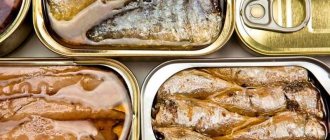Frozen or chilled shrimp can be bought in almost any supermarket, but the main point you should pay attention to is their freshness. If you buy processed and hermetically packaged in original packaging, the health risk is minimized; the date must be stamped on the package and the expiration date of the product inside is indicated. If you buy frozen, but not packaged shrimp (by weight), pay attention to the smell. It should be absent in glazed products, and when dry frozen it should be weakly expressed and fishy. A strong fishy or rotten smell indicates that the purchase should be abandoned. Remember, all seafood belongs to the group of perishable goods, and poisoning with them is extremely dangerous. Read more about how to choose the right shrimp in the supermarket, how and how long they can be stored chilled and frozen. Let's look at the GOST requirements and tell you how to identify low-quality goods before purchasing.
How to choose
When purchasing these crustaceans, you should pay attention to the general appearance of the shell. It should be evenly colored, without dark spots. The tails of crustaceans should be tucked. If the tails are straight, this may indicate that the shrimp died long before they were frozen. The yellow tint of the meat also does not indicate their freshness. Therefore, it is better not to buy such a product.
Unfortunately, since the early 70s of the last century, there have been a large number of shrimp farms in Indonesia, China, Vietnam, etc. On these farms, in pursuit of super-profits, these crustaceans are grown in cramped conditions. In this case, many crustaceans die, and the rest are in the same water and are maintained with the help of antibiotics, fungicides, organophosphates, etc. Such shrimp are simply dangerous to health, as they contain a large amount of toxic chemicals. Therefore, if you are not confident in the quality of the product, it is better not to buy it at all.
To avoid poisoning, you should not eat shrimp with the following symptoms:
- black head (an indicator of a serious illness of the crustacean);
- the presence of snow and ice in the packaging (probably the product was defrosted during transportation);
- unpleasant pungent odor.
A fresh, high-quality product should have the smell of the sea.
Peeled shrimp, despite their higher price, have a shorter shelf life than unpeeled shrimp. This also needs to be taken into account when purchasing them.
How to tell if seafood has gone bad
You should not try shrimp before purchasing. The taste of freshly frozen or boiled in this way is almost impossible to determine - solid ice. You should be guided by smell and appearance. Signs of damage:
- Soft shell - easily pressed through with the slightest pressure.
- When defrosting, the carcass disintegrates.
- Dark spots appeared under the shell. Even one or two indicate the beginning of damage. It is advisable to look at the carcass in the light - then the inclusions are easier to notice.
- An uneven pale pink tint of boiled or glazed carcasses, a white coating on the shell is a sign that the rules of freezing or storage were not followed.
Attention! One of the signs of loss of presentation is a blackened head. But the green head of freshly frozen or chilled shrimp indicates quality and naturalness. In their natural habitat, crustaceans feed on plankton, so this color is natural.
Yellowish stripes and pigment spots on chilled crustaceans are not signs of spoilage. But it is not recommended to buy them. This is a sign of age, and the meat of adult shrimp is tasteless - tough or flabby.
But the main indicator of quality is aroma. Tasty and fresh products smell of breeze, sea, algae and fish, while spoiled ones have an ammonia hue. Frozen shrimp should be slightly thawed before judging. If you are unable to purchase quality products, you should abandon the preparation.
How long can shrimp be stored?
Fresh shrimp can be stored for no more than 3 days. Frozen, they will stay fresh for about 2 months. Although it is believed that the maximum shelf life of shrimp in the freezer is 4 months. It should be understood that after two months of storage in the freezer, the taste of these crustaceans significantly decreases. The meat becomes tough and tasteless. It is best to store shrimp in the freezer if they are wrapped in foil. This will extend their shelf life by 1 - 2 months.
Important! After just 2-3 months of storage in the freezer, crustacean meat will lose its taste and nutritional value.
- After defrosting, crustaceans can be stored on the refrigerator shelf for no more than 2 days.
- The shelf life of boiled shrimp is no more than 3 days in the refrigerator.
How to cook shrimp
I would like to show you a simple shrimp recipe that many will like. You will need:
- Shrimp 1kg with shell;
- Garlic 4 cloves, but more is possible;
- Rosemary half a teaspoon;
- Tablespoon of vegetable oil
- Salt to taste.
Let's start cooking
- Rinse shrimp with cold water;
- Chop or press the garlic;
- Heat a frying pan, add oil, wait 1 minute;
- Fry the garlic with rosemary until golden, 2-3 minutes;
- Arrange shrimp in one layer;
- Fry until the shell is slightly dark;
- To serve, garnish with herbs and give each person half a lemon to squeeze.
- Ready!
| Shelf life of shrimp in the refrigerator | 3-5 days |
| Shelf life of shrimp in the freezer | 5-6 months |
| Shelf life of shrimp at room temperature | 2-4 hours |
| Shelf life of fried shrimp | 2-3 days |
| Shelf life of boiled shrimp | 3 days |
Results
Shrimp is a popular seafood product, the storage of which requires special attention. The main task of the buyer is to choose a quality product in the store and prepare it correctly. It is better to cook seafood in small portions, but if the dish has not been eaten, it can be kept in the cold for some time. Boiled shrimp can be stored in the refrigerator, but no more than 5 days, then they will spoil. If this period is not enough, they can be frozen, then the storage period will be extended to 6 months. Choose only a high-quality product and follow all the rules for storing it - this is the key to health.
Sources
- https://hozzi.ru/hranenie/krevetki-v-morozilke
- https://holodilnik1.ru/gotovka-i-hranenie/sroki-i-pravila-hranenija-varenyh-krevetok-v-holodilnike/
- https://kakxranit.ru/produkti/kak-xranit-krevetki.html
- https://KeepOK.ru/skolko-hranyatsya-varenyie-krevetki-v-holodilnike
- https://rem.ninja/kuhnya/hranenie/skolko-hranyatsya-krevetki-v-varenom-i-zamorozhennom-vide.html
- https://sroki.net/srok-hraneniya-krevetok/
Storage conditions
- Fresh shrimp should be stored in the refrigerator at a temperature of +2°C -+6°C for 3 days. When these crustaceans need to be preserved longer, they are frozen.
- Shrimp should be stored in the freezer at a temperature of at least -20°C. In such conditions they will be able to maintain their quality for up to 4 months.
- You can increase the shelf life in the refrigerator by placing crustaceans with seaweed and crushed ice in a colander. You can store shrimp this way for 4-5 days, provided they are placed on the top shelf of the refrigerator. Ice needs to be replaced as it melts.
Basic storage rules
If the shrimp were purchased fresh, that is, chilled, they cannot be stored. I also do not recommend freezing products, because after a radical decrease in temperature, the meat loses a significant part of its beneficial and taste characteristics. You can store chilled shrimp in the refrigerator for no more than a day. At the same time, it is worth placing them in the coldest zone to avoid premature spoilage of the product.
Frozen shrimp can be stored in the freezer for 2 to 4 months (the optimal period depends on the heat treatment method used). You can also extend the shelf life of crustaceans by wrapping the fresh product in food foil. In this form they will be stored for about 6 months, but the taste will be partially lost.
Storing the product after defrosting is not recommended, but if you cannot boil the shrimp immediately after defrosting, place them in the refrigerator. There they will lie and not deteriorate for 2 days.
How to store in the refrigerator
How much shrimp will retain their freshness when kept in the refrigerator depends on the power of the unit. The temperature should be between 2 and 8 degrees, while a low value is better than a high one, so always place seafood in the coldest zone. Also pay attention to the following rules:
- If the product is sealed, do not open it. Place it and the bag in a container and cover with a cloth to reduce evaporation.
- If the shrimp were purchased by weight, remove them from the disposable bag, place them in a food container and cover with a cloth or wrap in kitchen foil.
- If the product defrosts during storage, there is no need to drain the excess liquid. Shrimp need moisture or they will dry out during storage.
The shelf life of boiled shrimp in the refrigerator reaches 5 days, and fresh up to 3 days.
Advice! If seafood is not packaged airtight, isolate it from other products, otherwise they will become saturated with fishy aroma.
Basic rules for storing in the freezer
Note! According to GOST 20845-202, which is in force in Russia, Ukraine and other countries of the former CIS, “the mass of glaze when leaving the manufacturer must be at least 2% relative to the mass of the glazed block.” This condition must be observed unquestioningly, otherwise the buyer simply overpays for water.
According to the requirements described in GOST, the maximum shelf life of a frozen product is up to 6 months. If this condition is met, the shrimp remain edible, but taste inferior to fresh. The most optimal period to preserve the taste is 2-3 months.
The storage result and taste of the product after defrosting largely depends on the methods used. It is better if the shrimp died during the freezing process, this is indicated by a bent tail. To ensure this condition, the manufacturer uses shock freezing with liquid nitrogen.
The taste of crustaceans can also be ruined if they are defrosted incorrectly. Do not throw a frozen product into boiling water and wait for it to melt. Only thawed shrimp are suitable for boiling. However, you cannot leave them at room temperature; place them on the top shelf of the refrigerator. Please note that repeated freezing is unacceptable.
Storage at room temperature
Keeping shrimp raw without additional cooling is unjustified; they can become unusable in just a few hours, but in case of an emergency there is a way out:
- Dissolve salt in clean cool water and place seafood in it. This way it will retain its qualities throughout the day.
- If the shrimp are chilled, wrap them in food foil, making sure it's wrapped tightly.
- If it's cold outside, put the product in an airtight box and send it to the balcony.
Boiled shrimp should not be immersed in cold, salted water. They can be safely stored at room temperature for 5 hours.
How to Preserve Boiled Shrimp
Boiled shrimp can be stored in the refrigerator without loss of taste for 3 days. To do this, I recommend observing the following conditions:
- Wrap shrimp in parchment paper or foil. Try to remove as much air as possible from such packaging.
- Before storing the product, it must be thoroughly dried; if water remains on the surface of the seafood body, it can quickly deteriorate.
- Keep boiled crustaceans away from other foods. They give off a distinct fishy smell that can permeate the rest of the refrigerator.
- If you plan to store shrimp for a long time, add more salt when cooking, it acts as a preservative. Its properties will help avoid product spoilage.
- Place cooked shrimp in the coldest area, on a shelf reserved for entrees and meats.
Before use, carefully inspect the stored product to prevent premature spoilage, because it can be caused by various factors independent of the quality of packaging and storage conditions. If the raw material was of low quality, it will not be stored for long in boiled form.
It is better to cook shrimp before direct consumption, but if the dish could not be consumed immediately, or there are several servings left after the meal, they can be frozen. This method cannot be called preferable, but in terms of extending the shelf life it is the longest. Shrimp frozen after cooking can be stored for 3 months. Pack the cooked shrimp in quantities needed for one use because only one defrost is allowed. To ensure this, the product must be refrigerated the day before use.
Results
Shrimp is a popular seafood product, the storage of which requires special attention. The main task of the buyer is to choose a quality product in the store and prepare it correctly. It is better to cook seafood in small portions, but if the dish has not been eaten, it can be kept in the cold for some time. Boiled shrimp can be stored in the refrigerator, but no more than 5 days, then they will spoil. If this period is not enough, they can be frozen, then the storage period will be extended to 6 months. Choose only a high-quality product and follow all the rules for storing it - this is the key to health.
Video: how to cook shrimp
How and How Much to Cook Shrimp boiled frozen unpeeled cooking frozen super answer
Watch this video on YouTube
Do you want to understand better than others?
- Shelf life of boiled squid in the refrigerator - Squid is a popular seafood product that acts as a source of protein. Necessary for the normal functioning of the human body. All protein foods, in particular all seafood...
- Features and shelf life of fresh and prepared mushrooms in the refrigerator - After harvesting mushrooms, you do not always have the strength to immediately process it. Therefore, there is a need to place the product in storage. Shelf life depends on the type and method...
- How to store live, boiled and frozen crayfish in the refrigerator - Boiled crayfish are one of the most common beer snacks. This product has a lot of positive properties and is very beneficial for health, but also has very strict restrictions on...
- Shelf life of various types of eggs in a household refrigerator, depending on storage conditions - Eggs are perishable products and are one of the most irreplaceable products, present in almost any refrigerator. In rural settings they are also used for…
- Extending the shelf life of dumplings in the freezer - Almost everyone has dumplings in the freezer. This type of semi-finished product is a good solution for anyone who periodically needs quick cooking...
Chilled
Not only storage temperature affects the shelf life of shrimp, but also the type of packaging.
- The weighed product is wrapped in wax paper or foil. You cannot keep crustaceans in a plastic bag: they will quickly deteriorate.
- Storing boiled shrimp in the refrigerator is almost the same as storing a fresh-frozen product. They differ only in the duration. You can keep boiled crustaceans on the refrigerator shelf for no more than 3 days.
- Crustaceans have a specific smell. Therefore, they are kept in the refrigerator separately from other foods so that they do not absorb it.
- To store this product, it is better to choose a cooler place in the refrigerator.
You can store shrimp in the refrigerator for a maximum of 5 days.
What factors affect shelf life?
Shelf life is influenced by such factors.
Feedstock
A premium product contains at least 62% muscle tissue. Such meat is not frozen, so the product is less susceptible to pathogenic microflora. The shelf life of such products is long. Sausages of the first and second grade have less than 58% muscle tissue.
Production technology
Most types of sausages are first boiled and then smoked. Cooking time depends on the thickness of the stick. Then the product is additionally dried for 3 days. The shelf life of smoked products is much longer.
Type of shell
The shell is used to maintain the shape of the product and protect against the penetration of various bacteria and dirt. When purchasing, you need to carefully inspect the packaging. There should be no signs of deformation or damage.
Natural
The main advantage of such a shell is that it is allowed to be eaten. But along with this advantage, there are also disadvantages:
- it takes longer to manufacture the product;
- such a shell is difficult to peel off;
- storage periods are minimal.
Semi-synthetic materials
The shell is made of semi-synthetic material and does not allow air to pass through and does not allow the penetration of external unfavorable factors. If all conditions are met, the product can be stored for up to two weeks.
Vacuum packed
The result of improving sausage production technology was the creation of vacuum packaging. It allows you to preserve the taste, smell and freshness of the product much longer (up to 4 weeks).
Storage without refrigeration
At room temperature, fresh shrimp can spoil very quickly, in just a few hours.
But if there is a need to keep them without refrigeration, it is better to place the crustaceans in salt water. This will extend their freshness for another 2-3 hours.
To keep already chilled shrimp warm for as long as possible, they are wrapped in several layers of foil and put in the coolest place in the apartment, which is closed from sunlight.
Boiled shrimp are stored at room temperature for 2 – 4 hours. On average, these crustaceans will remain fresh for up to 5 hours without refrigeration.
Those crustaceans that lost their appetizing appearance during storage, and instead acquired an unpleasant odor and a light coating, most likely have spoiled. This product should not be eaten under any circumstances. Seafood poisoning is considered one of the most serious.
Additional tips and tricks
If you plan to eat the product in the coming days, then it is permissible to buy it for any period of time. First study the expiration dates indicated on the packaging. For long-term storage, it is better to choose a product in sealed packaging.
To prevent the cut of the stick from drying out, it is treated with egg yolk or lemon juice. If the stick has dried out over time and become hard, it is recommended to hold it over steam for 16 minutes. After this, they are put into the refrigerator compartment. To quickly remove the casing from the sausage, place the stick under cold water. If you follow all the recommendations and rules for storing sausage products, you will be able to preserve the taste and quality of the raw materials for a long time.
Share link:
General storage table
| Where to store | How long to store |
| Fresh in the fridge | no more than 5 days |
| Fresh in the freezer | maximum 4-5 months |
| Fresh at room temperature | few hours |
| Boiled/fried in the refrigerator | no more than 3 days |
How long shrimp can be stored is a very important question. It is worth carefully monitoring the condition of seafood that you eat, so that you don’t end up in the hospital due to improper storage.
How to store for a long time
Dry and store - up to 2 years
For long-term storage, shrimp can be dried: boil with spices and salt, spread in one layer on a baking sheet and place in the oven for 3-4 hours at a temperature of 50-60 degrees with the door open and preferably convection turned on. Place dried shrimp in containers and store for up to a year at room temperature.
Frozen - up to a year
If you brought frozen shrimp from the store and they did not have time to defrost, you can remove them from the freezer and store them there for up to 12 months, at a temperature of 18-24 degrees. If you bought chilled shrimp and decided to freeze them for future use, then it makes sense to make your life as easy as possible. Clean the shrimp from the intestines and, if desired, from the shell. Then divide the shrimp into portions and wrap in foil or plastic wrap before freezing. Don't throw away the shells, but put them in a bag and freeze them. Frozen shells can be used to cook soup soup.
Fresh and chilled – up to 5 days
Thawed or chilled shrimp can be stored in the refrigerator for up to 3 days. It is better to buy chilled shrimp in vacuum packaging, then they will be stored for up to 5 days.
Shelf life of shrimp - boiled and frozen
Boiled shrimp is a tasty and healthy dish that is often eaten at one time. If too much has been cooked, then you will often have to put it in the refrigerator. At the same time, care must be taken that the product does not spoil, otherwise it will cease to be tasty. The easiest way to preserve frozen shrimp is because they can last in the freezer for a long time. At the same time, you need to make sure that they do not spoil, because after a long period they will no longer be tasty and healthy.
The shelf life of frozen and boiled shrimp is significantly different. For this reason, it is imperative to figure out during what period the product will have to be consumed.
Shrimp shelf life
The period for which shrimp can be stored in the refrigerator will depend on both the type of product and the conditions of storage.
The longest storage time is for shrimp frozen alive. Ready-to-eat, for example, fried shrimp have a significantly shorter shelf life even when stored in the freezer.
When storing shrimp in a common refrigerator compartment, the following requirements must be met:
- the temperature in the common chamber should be from 4° to 6°C;
- The shelf life of shrimp cannot exceed 3 days.
To ensure longer storage of shrimp, you will need to place them in the freezer.
The conditions and shelf life of shrimp in the freezer can be represented as follows:
- the temperature in the freezer should be about -20°C;
- The shelf life of shrimp in the freezer can be up to 4 months.
Separately, you can consider storing shrimp with ice. In this case, they are placed in a colander, layered with sea grass and finely crushed ice. Place a colander in the pan so that the draining liquid does not accumulate in the shrimp. Shrimp cooled in this way can remain suitable for consumption for up to three days, at a temperature of about 0°C - up to five days.
It is worth knowing that shrimp spoil very quickly at room temperature. From the moment of defrosting, shrimp remain edible for literally several hours. Therefore, in order to prevent food poisoning, thawed shrimp cannot be re-frozen.
Shrimp shelf life
- Shelf life: 5 days
- Shelf life: 7 days
- Shelf life in the refrigerator: 5 days
- Freezer life: 150 days
Storage conditions: In the refrigerator at a temperature of +2 to +6 ° C
Currently, you can buy shrimp in almost any supermarket, but in all of them they will be frozen or, at most, chilled. When choosing shrimp, the first thing you need to pay attention to is the smell. If chilled shrimp have no flavor or the shell is not translucent, then the product is not of the best quality.
It’s not for nothing that all seafood is considered dangerous. Due to the fact that their shelf life is not very long, improper storage conditions can lead to poisoning.
In the store we can find frozen raw and boiled shrimp, as well as ready-made dishes that can be simply reheated or canned. The latter will cost slightly higher than other types.
In most cases, frozen shrimp are sold. If the product is of very high quality, then there will not be a lot of ice on it. Also, you should not buy if there are dark spots on the shrimp. If the ice in the bag is crunchy, it means that this bag has been frozen more than once, which can also affect the quality of the product.
The taste and benefits of shrimp depend on the conditions under which they are stored. They contain potassium, calcium, magnesium, sodium, cobalt, phosphorus, iodine, manganese, copper, molybdenum, fluorine, zinc, as well as vitamin E (tocopherol), iron, C (ascorbic acid), B1 (thiamine), B9 (folic acid), PP (niacin), B2 (riboflavin), provitamin A (retinol) and B-carotene. There are several nuances.
It is better to defrost shrimp gradually. If they were originally in the refrigerator, then first it is better to simply transfer them to the refrigerator, and then, after a while, defrost them at room temperature. To ensure that the shell can be easily removed after cooking, it is better to dip the shrimp in cold water for a few minutes.
Fresh shrimp are rich in vitamins and minerals. And if the storage period is not met, then the benefits are reduced significantly. And what’s worse, it’s very easy to get poisoned by expired seafood products.











